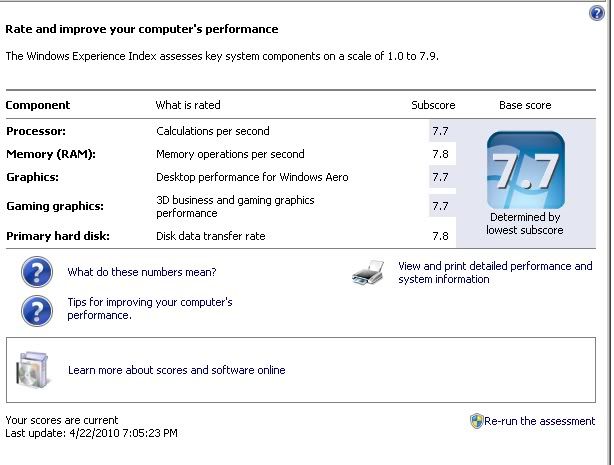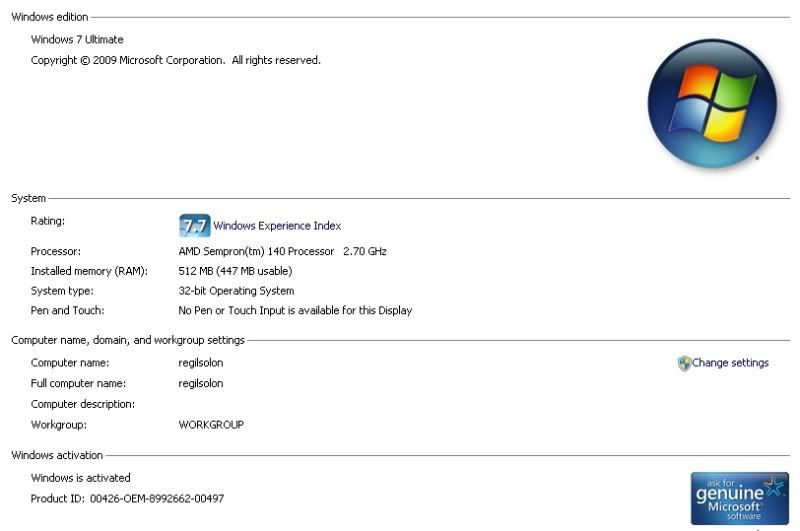The WEI, first introduced in Windows Vista, and now available in Windows 7, is a standardized basic benchmarking tool to allow a non-technical user to evaluate the performance of different systems. It is far from perfect. There are better benchmarking tools out there (and there are worse ones too), but it serves as a good starting point to get a good picture of a system's weakest point. This post is not a discussion of its merits and faults. I know there are people who want to know what kind of computers are most popular in Cebu.
So, post your WEI scores, and let's see what's out there...
In my rig, the graphics is my weakest link, and is the component I should upgrade first. I upgraded my 7900GS 256-bit 256MB (5.9) to a 9800GT 128-bit 1024MB (4.1) but WEI dropped to 4.1. I learned this was because the 128-bit interface moves so slow, a 7900GS will most like render faster because of inferior memory alone. I learned a lot because of WEI. So while new cards (GPU) are cheaper because of a 64-bit/128-bit interface, they just do not perform as well as they can if they had a 256-bit/512-bit higher-spec memory.
Most computers, especially laptops will most likely show storage as the weakest link. The fastest, non-raid, non-ssd, SATA setups I have seen makes 5.9 in this area. Mine is 6.1 using non-raid sata just by enabling AHCI and ultimately NCQ.
Fastest processors in the i7 range will give you a 7.9 which is the upper ceiling of what's available now. As architectures change, Microsoft will make this upper limit higher. My PC isn't a i3/i5/i7, but a normal quad core sitting on a 775 socket, but it is 45nm and has 6MB. So that helps.
Results 1 to 10 of 34
-
05-14-2010, 08:57 PM #1Junior Member

- Join Date
- Mar 2008
- Posts
- 313
 Post your WEI (Windows Experience Index)
Post your WEI (Windows Experience Index)
-
05-14-2010, 09:08 PM #2

there's a similar thread i created about this...
https://www.istorya.net/forums/how-to...-its-best.html
then again, the scores are a little higher so merging this and the other one would be better.
-
05-14-2010, 09:51 PM #3Junior Member

- Join Date
- Mar 2008
- Posts
- 313

oh good! i missed that. is there an easy way to merge?
-
05-14-2010, 09:52 PM #4Junior Member

- Join Date
- Mar 2008
- Posts
- 313

RELATED THREAD (VISTA WEI) IS NOT ACTIVE ANYMORE. Last post: 09-03-2008, 10:24 AM
-
05-14-2010, 11:09 PM #5
-
05-20-2010, 06:33 PM #6

- Join Date
- Apr 2010
- Posts
- 255

mao ni ako...

-
05-20-2010, 06:45 PM #7Senior Member
![[-erick-] is offline](images/metro/blue/statusicon/user-offline.png)
- Join Date
- Mar 2006
- Posts
- 525


i need ssd.
-
05-20-2010, 09:17 PM #8
-
05-20-2010, 10:16 PM #9
-
05-20-2010, 10:57 PM #10

here's mine. believe it or not.


Similar Threads |
|





 Reply With Quote
Reply With Quote


